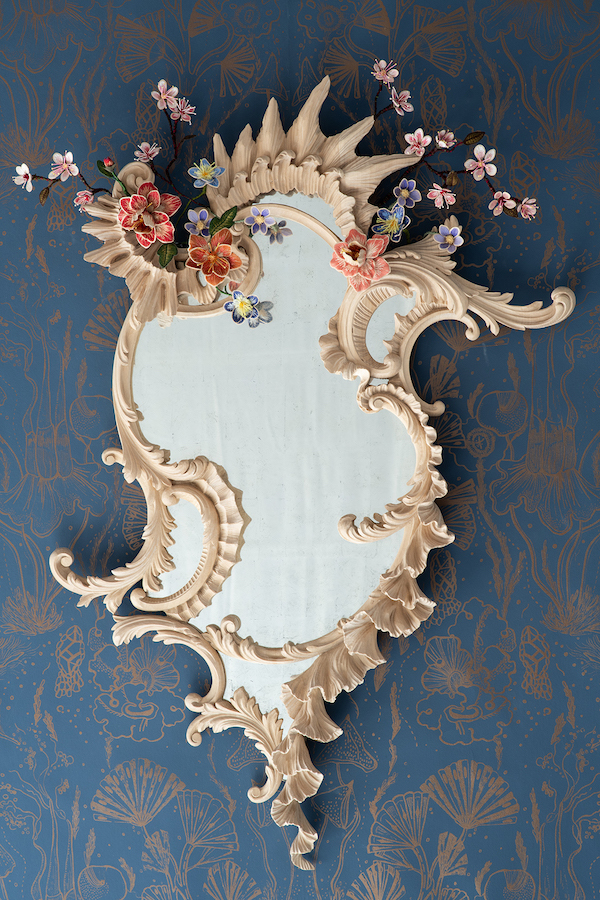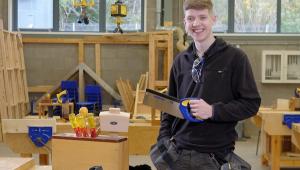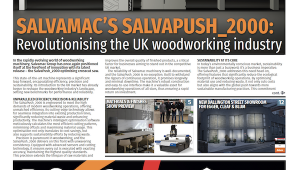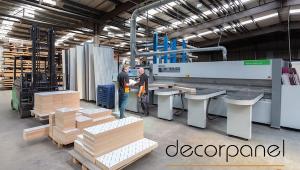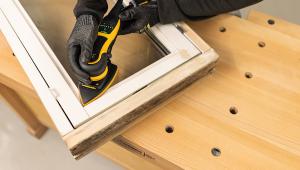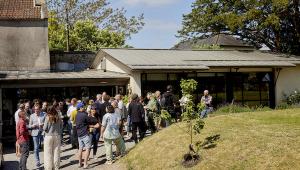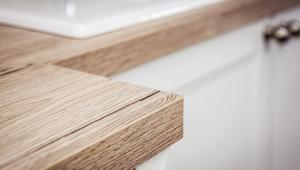Wood Awards 2023 Shortlist announced
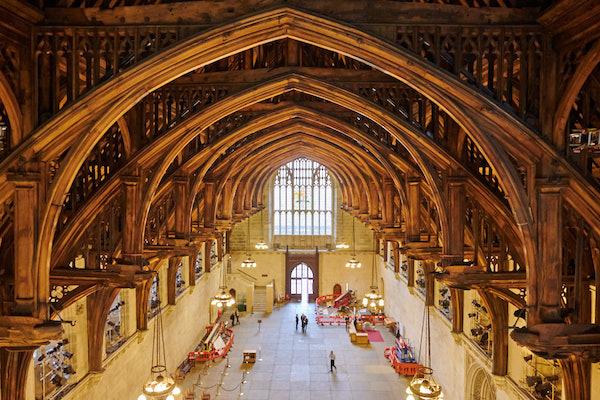
20 buildings and 14 furniture projects have been shortlisted for this year’s Wood Awards, all of which celebrate excellence and innovation in timber architecture and design.
From over 200 projects entered, this shortlist of 34 entries celebrates the diversity and creativity of buildings and furniture made using the world’s foremost sustainable and renewable material – wood.
A seafront visitor centre, a concert hall and an office complex are among the shortlisted buildings for the 2023 Wood Awards, while lathe-turned lamps, a table-cum-musical instrument and a community-built table set are among the furniture and product projects.
The Awards are split into two main categories: Furniture & Product and Buildings. Buildings are split into the following categories: Commercial & Leisure, Education & Public Sector, Interior, Private Sector, Small Project, and Restoration & Reuse. Within Furniture & Product, there’s three subcategories: ‘Bespoke’, ‘Production Made’ and ‘Student Designer’.
BUILDINGS
Spanning significant public spaces, forward-thinking offices and unique private homes, the 20 shortlisted structures, listed below, provide a snapshot of exemplary and progressive timber architecture.
Shortlisted projects for the Building Categories of the Wood Awards 2023 are:
• Black House Farm, Nr. Alresford – Robin Lee Architecture. A historic Hampshire farm complex that’s been elegantly reconstructed and reimagined through the introduction of a contemporary timber element, unifying the carefully restored agricultural buildings.
• Benenden School, Centenary Hall and Music School, Kent – Hollaway Studios. By engineering timber to its fullest auditory potential, this world-class concert hall and music school buildings transforms the musical and cultural education of Benenden’s pupils.
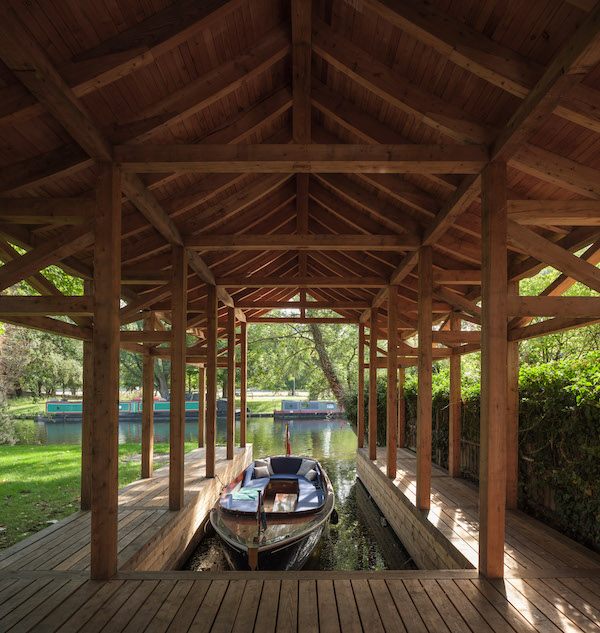
• The Boathouse, Cambridge – Ashworth Parkes Architects. Built using Japanese carpentry techniques and no mechanical fixings, this larch boathouse sits elegantly on the bank of the River Cam.
• Butterfly House, London – Oliver Leech Architects. Nestled within a small corner plot in Esher, this timber-frame house carefully explores form and material to provide a compact home supporting multi-generational living.
• The Black & White Building, London – Waugh Thistleton Architects. Setting a new standard for sustainable and innovative workspace architecture, this landmark mass timber office complex is founded on low-carbon construction, circularity and natural materials.
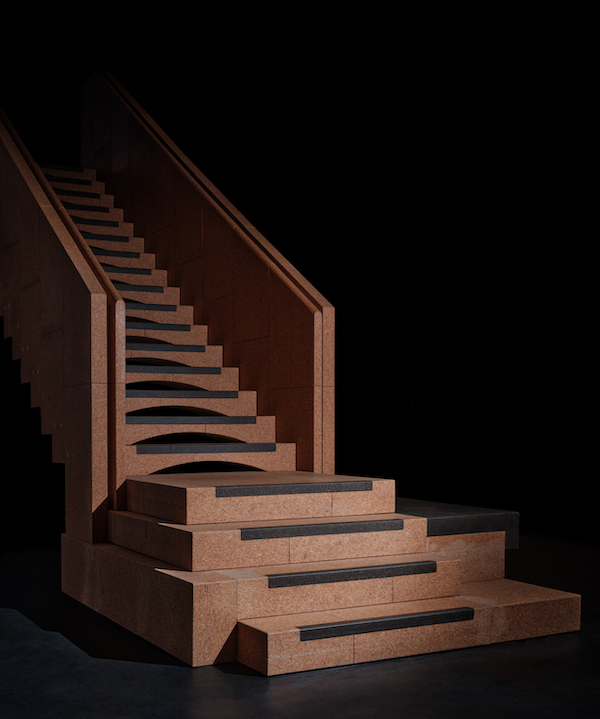
• The Cork Stair at the Building Centre, London – Roz Barr Architects. The world’s first self-supporting staircase made of cork was commissioned as part of a wider refurbishment of the Building Centre’s exhibition space.
• Dark Matter, Tring – Hyperspace. With a minimal but textured plywood interior and charred timber façade, a former garage has been converted into a tranquil garden studio designed to foster garden biodiversity.
• Dragon Flat, London – Tsuruta Architects. AI-generated engravings adorn the timber wall panels and joinery of this refurbished 1950s council flat, bringing playful graphic detail to the transformed interior.
• Durley Chine Environmental Hub, Bournemouth – Footprint Architects. Bournemouth’s new seafront visitor centre is a showcase of sustainability-driven design and the reuse of timber in construction.
• Eton Sports & Aquatics Centre, Windsor – Hopkins Architects. This visually striking, high-performance mass timber facility provides an accessible 25m pool and a four-court multi-use sports hall for the school’s students.
• Field Station, Beaminster – The Design + Make Programme. Built from crown timber, this multi-purpose pavilion at Hooke Park marries technical innovation with a deep respect for nature, demonstrating the potential of modern architecture to contribute positively to woodland management.
• 20-23 Greville Street, London – Groupwork. With the classic appearance of a period dwelling, this newly renovated, repurposed and vertically extended office building in Farringdon reveals a contemporary CLT structure within.
• Lea Bridge Library Pavilion, London – Studio Weave. Making use of a mass timber primary structure, this single-storey extension revives the Grade-II listed Lea Bridge Library into a new civic heart for the community.
• Made of Sand, London – Studio Weave. A Douglas fir-built artist’s retreat has been added to a stone cottage in Devon, providing a creative work and holiday space immersed in its natural surroundings.
• New Temple Complex, Hampshire – James Gorst Architects. With a celebration of natural materiality embedded in local history, this forward-looking building is characterised by peaceful simplicity.
• NMIS (National Manufacturing Institute Scotland), Glasgow, Renfrew – HLM Architect. Pushing the boundaries for the application of engineered timber, the new NMIS headquarters is an inspirational learning environment with a unique structural identity.
• Serpentine Pavilion 2023, London – Lina Ghotmeh Architecture. Visually echoing the canopies of surrounding trees, this lightweight modular pavilion provides an enticing invitation for human interactions.
• Spruce House and Studio, London – ao-ft. This domestic haven uses cross-laminated timber for its structure and interior finishing to create a beautiful, minimal home that fits perfectly into its London terrace.
• St John’s College new dining room, bar, and café, Cambridge – MCW Architects. Exploiting the aesthetic and structural capabilities of engineered oak, the glulam superstructure is the centrepiece of this suit of new social spaces for St John’s College.
• Westminster Hall Roof and Lantern, London – Donald Insall Associates. This heritage conservation project has expertly repaired and rebuilt Westminster Hall’s exquisite medieval hammer beam roof and lantern.
Jim Greaves, Head of the Building Judges, says: “Selected from over 90 entries, this impressive shortlist reveals the best use of timber in construction today and demonstrates that wood truly is a material of continuous change and innovation. Our panel of judges will now visit each shortlisted building to determine this year’s winners – and select a stand-out project to receive the prestigious Gold Award. This rigorous process is one of the things that makes the Wood Awards the highest accolade in the UK timber industry.”
FURNITURE & PRODUCT DESIGN
The 14 shortlisted furniture and product items, listed below, reveal an accomplished array of materially engaged designs. Incorporating endangered heritage techniques, community-led production, innovative problem solving and poetic exploration, each of the entries tells its own story about how wood can transform and enhance our surroundings.
Shortlisted projects for the Furniture and Product Categories of the Wood Awards 2023 are:
• The Ash Bushel Basket, Bristol – Florence Hamer. Inspired by traditional techniques of split wood basketry, the Ash Bushel Basket is an odeto Scandinavian and North American basket-making craft cultures, made using British materials.
• Lace Oak Natural Edge Bowl, Lancashire – Greg Kent Art in Wood. Crafted from a storm-fallen piece of partially rotted oak, this delicate sculptural bowl has been sandblasted to expose the growth rings and decay of its material.
• Mixed-Deciduous Beam, London – George Fereday. Embracing the natural form and strength of ‘as-grown’ wood, this speculative structural beam has been designed to address the low use of locally grown hardwoods in UK construction.
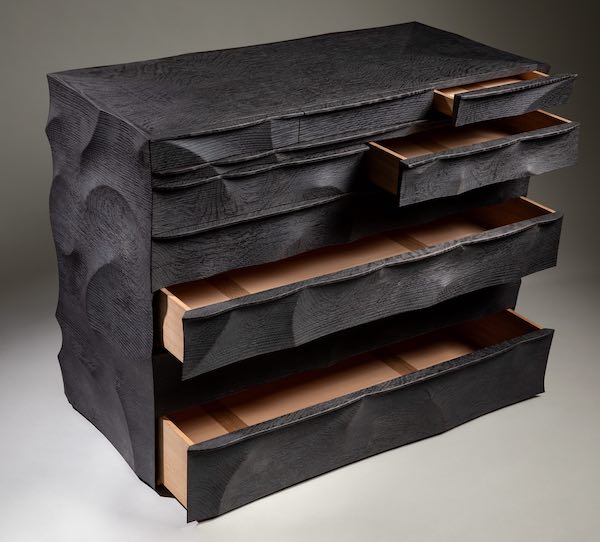
• Serenade, London – John Makepeace Limited. Inspired by ancient, hollowed-out tree trunks used to carry the possessions of those on the move, this bespoke oak chest accommodates the personal possessions of a less nomadic lifestyle.
• Axis Table, St Leonards-on-sea – Makermark. Incorporating the spherical and curving forms found in the study of planetary bodies and their cycles, the Axis Table draws on influences of the the Bronze Age’s monumental architecture.
• The Sound of Wood, London – George Richarson. Using a colourful array of 17 native and UK-grown woods, this engaging and playful project combines two passions: furniture and music.
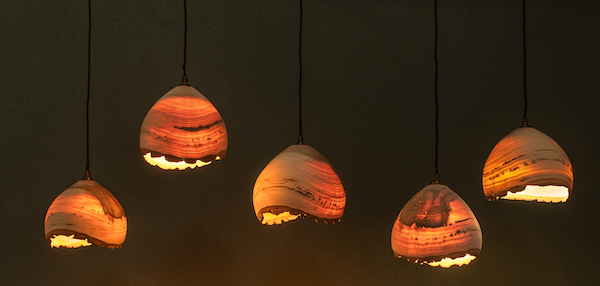
• Grain, Kent – Tamasine Osher. These lathe-turned translucent timber lights push at woodturning’s heritage craft boundaries.
• The Exchange Tables and Chairs, Erith – Mentsen. A true achievement of community-led design and production, these collapsible and stackable oak tables and chairs were made by local volunteers and staff at The Exchange Erith.
• COTTO’s Kyora Board, London – Studio Mama. Seeking to design a balance board as a functional work of art, Cotto’s Kyora Board is a celebration of the aesthetic of wood and its domestic qualities.
• The Hanger Collection, London – Barbara (Yixuan) Wei. Beginning with an interpretation of clothing hangers, this sculptural, contemplative project seeks to visualise a sense of intimacy with and between objects.
• Scutoid Stool/Side-Tables, Somerset – Guy Privett Designs. Inspired by the newly discovered ‘scutoid’ shape, these geometrically complex stool/side tables can be used independently or fitted perfectly together.
• Halved Lounge Chair, Kingston Upon Thames – Jack Allfrey. This economically efficient chair design utilises CNC machining in response to the recent rises in the price of birch plywood.
• Rocaille Morphosis, London – Joanne Grogan. This hand-carved limewood mirror fuses rococo ornamentation with marine life structures to create sumptuous, morphological forms.
• General Purpose Sofa, Kingston Upon Thames – Lukas Astrom-Wilcox. Hoping to revolutionise our approach to furniture maintenance, this versatile, cost-effective design tackles the re-upholstery challenges faced by traditional sofas.
Corinne Julius, Head of the Furniture and Products Judges, says: “Wood is a wonderful and often underrated, sustainable material. It’s a taken-for-granted material that deserves more respect. The Wood Awards are intended to showcase this natural material’s beauty and versatility and highlight its ability to connect us to the natural world. They also aim to inspire the industry, designers, makers, and students to gain a better understanding of wood in its myriad forms in order to create beautiful, intelligent products for an increasingly discriminating public.”
The Wood Awards shortlist will be on display from 20–23 September at Gallery@Oxo in partnership with the Material Matters Exhibition during the London Design Festival.
The winners of the 2023 competition will be announced on 22 November during an evening ceremony held at Carpenter’s Hall.
As a not-for-profit competition, the Wood Awards can only take place due to collaborative industry sponsorship. A huge thank you for continued support from Carpenters Company, American Hardwood Export Council and Timber Development UK.
For more information on the shortlist, see www.woodawards.com/archive/shortlist-2023/, and to view previous Wood Awards’ winners, visit www.woodawards.com.
- Log in or register to post comments
